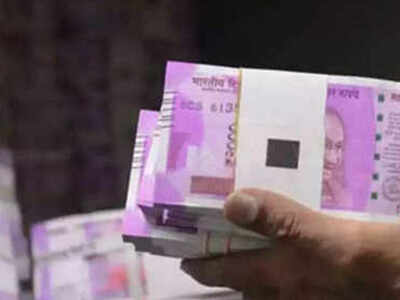
BHUBANESWAR: With the state’s overall revenue collection fallen by around 23% during the first quarter (April-June) of the current financial year, the finance department has borrowed Rs 4,830 crore in the past three months to meet the expenditure.
While Rs 3,000 crore has been borrowed from open market (from banks and other financial institutions), it has borrowed Rs 1,830 crore from the Odisha Mineral Bearing Areas Development Corporation (OMBADC) fund, said finance department sources.
“Since the Covid management and efforts to generate employment and livelihood opportunities would require huge expenditure, there would be a need to go for more borrowing in the coming months to meet the spending requirements. The revenue collection is unlikely to improve in the subsequent quarters because of the pandemic situation,” said a senior finance department official.
Official sources said it had never borrowed such a huge amount in the first quarter in recent years. Though states are allowed to borrow up to 3% of their gross state domestic product (GSDP), the Centre has recently allowed all state’s to borrow upto 5% of the GSDP because of depletion in revenue collection in view of the pandemic. While allowing states to borrow additional 2%, the Centre has set conditions like implementing four reforms in different areas.
The state government has been implementing the reforms suggested by the Centre to increase its borrowing limit. A senior IPS officer has been appointed as nodal officer to oversee implementation of specific reforms by various departments to increase the borrowing limit, the official said.
In the annual budget for this fiscal, the state government has estimated to borrow Rs 17,878 crore during the year, finance department sources said the actual amount of borrowing could be much more than what has been estimated in the budget because of slash in revenue collection.
Total revenue collection during the April-June period is estimated to be around Rs 8,204 crore against Rs 10,645 crore collected during the corresponding period of the previous fiscal.
Fall in revenue collection has also forced the state government to go for expenditure rationalization measures like ban on launching new schemes/projects, restrictions on government recruitment, reducing expenditure on travel and vehicle and barring establishment expenditures.
While Rs 3,000 crore has been borrowed from open market (from banks and other financial institutions), it has borrowed Rs 1,830 crore from the Odisha Mineral Bearing Areas Development Corporation (OMBADC) fund, said finance department sources.
“Since the Covid management and efforts to generate employment and livelihood opportunities would require huge expenditure, there would be a need to go for more borrowing in the coming months to meet the spending requirements. The revenue collection is unlikely to improve in the subsequent quarters because of the pandemic situation,” said a senior finance department official.
Official sources said it had never borrowed such a huge amount in the first quarter in recent years. Though states are allowed to borrow up to 3% of their gross state domestic product (GSDP), the Centre has recently allowed all state’s to borrow upto 5% of the GSDP because of depletion in revenue collection in view of the pandemic. While allowing states to borrow additional 2%, the Centre has set conditions like implementing four reforms in different areas.
The state government has been implementing the reforms suggested by the Centre to increase its borrowing limit. A senior IPS officer has been appointed as nodal officer to oversee implementation of specific reforms by various departments to increase the borrowing limit, the official said.
In the annual budget for this fiscal, the state government has estimated to borrow Rs 17,878 crore during the year, finance department sources said the actual amount of borrowing could be much more than what has been estimated in the budget because of slash in revenue collection.
Total revenue collection during the April-June period is estimated to be around Rs 8,204 crore against Rs 10,645 crore collected during the corresponding period of the previous fiscal.
Fall in revenue collection has also forced the state government to go for expenditure rationalization measures like ban on launching new schemes/projects, restrictions on government recruitment, reducing expenditure on travel and vehicle and barring establishment expenditures.

Coronavirus outbreak
Trending Topics
LATEST VIDEOS
City
 Gangster Abu Salem's aide Gajendra Singh arrested by Special Task Force from Noida
Gangster Abu Salem's aide Gajendra Singh arrested by Special Task Force from Noida  Minor raped in Covid-19 isolation ward of Patna Medical College and Hospital, guard held
Minor raped in Covid-19 isolation ward of Patna Medical College and Hospital, guard held  Not all pregnant women required to undergo Covid test, says Delhi government to HC
Not all pregnant women required to undergo Covid test, says Delhi government to HC  Bihar: 264 crore bridge inaugurated last month, washed away in Gopalganj
Bihar: 264 crore bridge inaugurated last month, washed away in Gopalganj
More from TOI
Navbharat Times
Featured Today in Travel
Quick Links
Kerala Coronavirus Helpline NumberHaryana Coronavirus Helpline NumberUP Coronavirus Helpline NumberBareilly NewsBhopal NewsCoronavirus in DelhiCoronavirus in HyderabadCoronavirus in IndiaCoronavirus symptomsCoronavirusRajasthan Coronavirus Helpline NumberAditya ThackerayShiv SenaFire in MumbaiAP Coronavirus Helpline NumberArvind KejriwalJammu Kashmir Coronavirus Helpline NumberSrinagar encounter
Get the app



